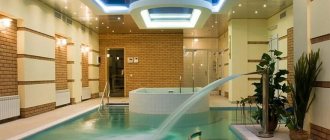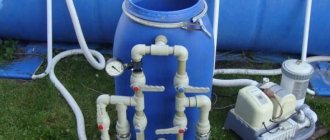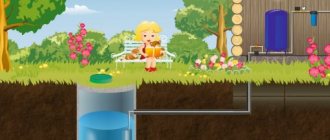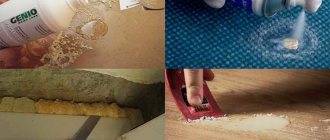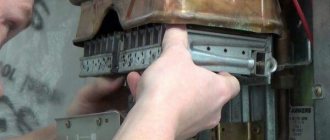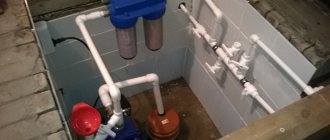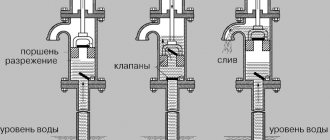Your own swimming pool is a real escape from the summer heat. However, over time, the water can become very contaminated, acquire a greenish color and an unpleasant odor. This is a signal that it is time to take action. From this article you will learn how to clean a pool without draining the water and return the pond to a decent appearance.
Regular maintenance of your favorite pool is the key to clean and transparent water.
How to clean the water in an inflatable pool
Special products will help clean the walls of the inflatable pool from dirt.
The most common type of pool among summer residents is an inflatable, small one. It is convenient and easy to use, but requires frequent water changes.
If your pool is small, the best way to clean the water is to change it completely. To do this you will need to do the following:
- Drain the contaminated water.
- Thoroughly clean the walls with the chosen product.
- Treat the internal surfaces with protective compounds, which are often sold complete with inflatable pools.
For larger pools, maintenance comes down to disinfection, removing dirt and clearing the walls of mucus. It is necessary to add a disinfectant once a week.
Mechanical cleaning
The cleaning option involves the use of hand tools. Suitable for removing debris from surfaces. But this method is not used to remove germs and bacteria. Among the devices that can be used are:
- Brushes to remove leaves, branches and debris;
- Nets that can be used to remove debris and foam formed by flowering;
- Vacuum cleaner for removing dirt from the walls and sand and dirt from the bottom.
This is the most popular method of putting a pond in order. It is carried out at least every other day.
How to clear green water from water in a pool at your dacha
Special agents - aldehydes - will help in the fight against greenery in the pool.
Over time, the water in the pool may turn green, mucus forms around the edges and an unpleasant odor appears - this is where microorganisms begin to multiply.
The chemical method of combating green water is the most effective. In order to disinfect water, they use agents such as aldehydes. They do not contain chlorine and are not hazardous to human health.
Along with aldehydes, chlorine-containing substances also act in the fight against water blooms. It can be liquid, powder or tablets. They should be used strictly according to the instructions; doses are calculated based on the volume of water.
A good way to purify water that has acquired a greenish tint is recirculation (a method of dealing with contaminants using filters and pumps).
Special filters and pumps will help ensure clear water in the pool.
Another method is an ultrasonic water purifying device. It is very effective and is able to clean not only algae, but also slippery deposits. The only negative is that such devices are quite expensive.
When starting cleaning using one or another method, carefully read the instructions and recommended operating procedures.
Chlorine-based chemicals
Such drugs remain popular due to their low cost and effectiveness. Disinfection of water with chlorine-based products (tablets, powders) occurs quickly. However, they are far from the best option. The reasons are a sharp, unpleasant odor of water, a possible allergic reaction. In addition, even a weak solution of chlorine preparations dries the skin, provokes irritation, and can also change the color of swimsuits and swimming trunks.
How to purify water in a swimming pool at the dacha
To purify water, two main methods are used - chemical and mechanical. The chemical method involves adding special substances that purify and disinfect water, and also stop the proliferation of microorganisms.
Ultraviolet light prevents bacteria and phytoplankton from multiplying in water.
The mechanical method is the use of various filters and devices that help not only purify the water, but also remove sediment from the walls of the pool. Filters can be:
- Mechanical. They remove impurities through a filter element. There are models combined with a transfer pump.
- Ultraviolet. The device is a flask containing a UV lamp. Ultraviolet light destroys bacteria and phytoplankton.
Both types of filters can be used simultaneously. In this case, the water is first disinfected with ultraviolet light and then filtered.
A special vacuum cleaner will help to cope with sediment on the bottom and walls. With its help, it will be easy for you to remove flakes that form during chemical treatment of water.
Skimmer for water purification.
Another device that will help the water stay clean is a skimmer. This device cleans the upper aqueous layer, which contains up to 80% of all microorganisms.
Cleaning the tank
So, we sorted out water purification. Next up is the second part of the article about cleaning the tank. There are much fewer options here and only mechanical methods are used. Since the walls and bottom of the tank are under water, it is difficult to reach them. Plus, it is necessary to carry out cleaning so as not to raise turbidity into the water. For this you need such devices.
- Here is a pool brush. A telescopic nozzle is put on it, which allows you to reach the walls and bottom of the tank. The disadvantage of this tool is that it picks up dirt from the day. Further water purification is carried out by filters, which indicates an additional and unnecessary load on them - the service life is reduced.
Pool brush
- Water purification using vacuum cleaners is much more effective, but such cleaning uses part of the water from the reservoir. A hose is connected to the outlet pipe on the brush, which is led outside the pool - dirty water will flow through it. Next, the brush is lowered into the water. Now you need to create a pressure difference by sucking water through the return end of the hose. As soon as the water flows, we begin cleaning - the dirt raised by the brush will be partially drawn in by the vacuum cleaner, and the water is drained through the hose.
Mechanical pool vacuum cleaner
- There is no water consumption here, although not all models have it. The device is equipped with an electric motor that draws water inside. It passes through a filter mesh in which debris particles of different sizes settle. The pump must operate under water.
Electric pool vacuum cleaner
- The most technically new method of tank cleaning will be a special robot. This baby has tracks or wheels and a complex sensor system that allows you to scan surfaces in the water. It can move both along the bottom and along the walls of the pool. Systematically and slowly, the robot vacuums the entire tank. A very funny toy that you can enjoy watching for hours.
Robot vacuum cleaner
There are also filters installed inside the robot that require periodic cleaning.
How to clear greens from pool water using folk remedies
You can purify the water in the pool not only with the help of special devices and chemicals, but also with folk remedies.
- The simplest folk method is to add table salt and baking soda to the water. Salt is taken at the rate of 5 kg per 1 ton of water.
- An equally effective remedy is ordinary brilliant green. You won’t need very much of it, only 3 bottles per 10 cubic meters. m of water.
Zelenka and hydrogen peroxide purify and disinfect water.
General care recommendations
Keeping the container clean takes a lot of time. Even when using a special awning, branches still fall into the pond, leaves, debris and dust are blown by the wind. If you do not clean the pool yourself, you will have to change all the water. To avoid this, you should follow these recommendations:
- Filter installation;
- Daily cleaning with a net;
- Treatment of water with chemicals - once every two to three weeks;
- Using an awning at night and in bad weather;
- In winter, the pool must be thoroughly dried and covered.
If a small inflatable “paddling pool” is used, the filling should be changed every 7-8 days and the surfaces located inside should be washed thoroughly.
How to clean a pool with hydrogen peroxide
The most common method of water purification among summer residents is the use of hydrogen peroxide. Due to the fact that this composition has excellent disinfectant properties, it is successfully used both for water purification and for its disinfection.
The advantages of such cleansing include the fact that peroxide helps get rid of foreign odors and decomposition products. Let's look at exactly how you can clean a pool with hydrogen peroxide.
If you want to clean your garden pool with hydrogen peroxide, you need to know exactly its volume. This is necessary in order to correctly calculate the dose of the substance.
If the pool is slightly dirty, after cleaning the pool with hydrogen peroxide, you can swim only after 24 hours.
For effective cleaning per 1 cubic meter. m, 700 ml of hydrogen peroxide is needed, and in case of severe contamination, the dose of this liquid is doubled. With this cleaning method, certain rules must be followed:
- be sure to use gloves;
- After treating the water, you can swim only a day later;
- if the water was heavily polluted and the amount of peroxide exceeded 1 liter per 1 cubic meter. m, then bathing is resumed only after 3 days.
To put your pool in order, you must follow a certain sequence of actions. The cleaning technology is as follows:
- Pour the required amount of hydrogen peroxide into the water.
- If a brown coating has formed on the walls and bottom, use a skimmer.
- After treatment, leave the pool open; there is no need to cover it with an awning.
If you did everything correctly, the water in the pool will be cleared and will not “bloom.”
Chemical methods
Using chemistry is an effective, simple, fast and inexpensive method. These drugs can be produced in the form of:
- briquettes;
- tablets;
- granules;
- powder;
- liquids.
Chemical cleaning allows you to disinfect water, get rid of algae and other foreign particles. It is important to monitor the optimal pH value.
Chlorine
- Chlorination is one of the most popular and inexpensive methods. This is the most effective option at high water temperatures (from 28° C).
- Chlorination ensures high quality of the procedure and a long-lasting effect: the effect continues for some time after completion of cleaning.
- The disadvantages of this method are an unpleasant odor and the possible occurrence of allergic reactions. Also, when using chlorine, water hardness increases.
Bromine
The drug is most often produced in the form of powder or slow-dissolving tablets. Bromine is an excellent choice for small indoor structures and hot tubs. Limited solubility prevents it from effectively handling significant displacement. Therefore, it is often used in combination with chlorine. This substance removes organic impurities from water, kills viruses, bacteria, and fungi.
- This is a hypoallergenic product that does not irritate mucous membranes and skin. Other advantages are the absence of an irritating odor, neutral Ph reaction.
- A significant disadvantage is the high cost.
Active oxygen
The drug purifies water well without changing its properties. The use of this product is justified if you have a small pool.
Active oxygen is ineffective in warm water (above 28° C). This drug must be used in strictly dosed quantities. It contains dangerous substances: Cl, HCl, arsenic, formaldehyde. Therefore, it is not advisable to use the product for a long time. An increase in the chemicals contained in the solution does not have the best effect on the skin.
Cleansing should be planned for the night, because after completing the procedure it is better not to go into the water for some time.
Hydrogen peroxide
This is a fast-acting drug that provides a long-lasting effect. Peroxide makes water sterile and clear. For swimming pools, you will not need a solution from a home medicine cabinet, but a special composition. They differ in the percentage of active substance 3% versus 37% in the preparation for improving water quality. It can be found in liquid, powder or tablet form.
Upon contact with water, the drug releases active oxygen, which has a disinfecting effect. This reaction also causes the algae to become discolored. Consumers are attracted by the absence of a strong odor and the hypoallergenic nature of this product.
Algaecides
As the name of the product suggests, it helps fight algae, which is also called cyanobacteria. The drug also prevents the development of fungus.
Measures such as using chlorine and regularly changing water do not completely solve the problem. Most cyanobacteria remain viable due to the presence of a protective membrane. Under the influence of algaecides, the cell membrane dissolves, and organisms become vulnerable to attack by aggressive substances. These drugs are also recommended to be used to prevent the appearance of algae.
Coagulants and flocculants
Coagulants and flocculants allow you to eliminate the smallest particles of contaminants that the filter cannot handle. Such preparations glue such specks together. As a result, a kind of flakes are formed, the size of which allows them to be filtered or eliminated mechanically. The reagents differ from each other in their mechanism of action and the magnitude of the resulting compounds. Flocculants lead to the formation of larger sediment.
To achieve the best effect, it is recommended to use cartridges with coagulants. They are installed in a filter, which ensures constant water purification.
Products for maintaining pH levels
The optimal pH value is 7.2-7.4 . This creates a slightly alkaline environment, ensuring effective disinfection and good condition of the skin and equipment.
Specified pH level:
- will prevent the formation of limescale on the bowl and pipes;
- will minimize corrosion of metal elements of equipment;
- protects skin and eyes from irritation;
- will determine the economical consumption of disinfectants.
To bring the acid-base balance back to normal, you can use special preparations: pH+ and pH-. Among the folk remedies, baking soda is suitable to increase the indicator, and hydrochloric acid is suitable to decrease it.
How to clear cloudy water from a pool
If the water in the pool quickly becomes cloudy, then coagulants will help.
Cloudy water may be caused by dust, clay or pollen entering the pool. Such particles may not be captured by filters, and additional means will be required.
In this case, you can treat the water with coagulants. These compounds are capable of transforming microparticles of dust and small debris, first into a jelly-like state, and then into flakes. This mass is subsequently collected with a special vacuum cleaner.
If the water has become cloudy due to contamination with microorganisms, treatment with special disinfectants will help.
Filters
Filters are a mechanical cleaning method. Thanks to them, you can remove small particles and clean all layers of pool water. It should be remembered that the filter must be selected taking into account that it has time to pass water through itself 2-3 times per day.
They need to be washed once every 10 days, and cleaned several times a year. Installation of filters should be carried out by a specialist.
There are many types of filters, each of which has pros and cons.
| Filter | pros | Minuses |
| Sand |
|
|
| Diatomaceous earth |
|
|
| Cartridge |
|
|
More details about filters: Filters
How to remove iron from pool water
If the water in the pool has a brownish tint, this means that metal deposits have appeared in it. The reasons for this phenomenon may be:
- use of reagents containing iron;
- presence of rust in the pipeline system.
Rusty water looks unpresentable, but does not pose any particular danger to human health. But the metal deposits have a negative effect on the pool itself, and rust appears on the parts over time.
Pool filter.
To purify pool water from iron, various filters are used:
- reverse osmosis (with a large amount of iron);
- ion exchange (for a small amount of metal and a water pH of at least 7);
- filter with replaceable cartridges (for water in which the metal content does not exceed 4 mg/l);
- multi-layer iron removal filter that purifies water from metal and organic impurities.
These methods are most effective for purifying water from rust and removing microparticles of metals.
